10 Great Personal Brand Statements and How To Write Yours
Most personal brand statements include a job title, an industry, and maybe an insight into the person's personality.
That formula effectively communicates the value you can provide to the world and what you do, but there's one problem – it's the exact same format everyone else uses.
So, even though that formula works, you won't stand out from anyone else in your industry.
While using that formula is certainly better than writing a vague personal brand statement that leaves the reader guessing what you do, there are better ways to craft a personal brand statement that sets you apart from the competition.
In this post, we'll discuss how to craft a compelling personal brand statement and then provide examples of outstanding personal brand statements that you can use for inspiration while creating your own.
What Is a Personal Brand Statement?
A personal brand statement is a few sentences that clearly communicate who you are as a professional and the value you have to offer.
A great personal brand statement also defines how you're different from everyone else and intrigues your ideal target audience to read more.
You'll find that most people post their personal brand statements on LinkedIn, Twitter, and their website. You can also use this as your elevator pitch when introducing yourself to others at conferences and events.
Personal Brand Statement Best Practices
As you craft your personal brand statement, here are a few best practices to remember.
Clearly Communicate Your Value
Many people try to get too creative with their personal brand statement, and the value they offer becomes muddled.
Unfortunately, potential employers and clients scrolling through LinkedIn profiles won't pause and attempt to decipher what you do and how you provide value.
For example, "building awesome things" is a poor personal brand statement because nobody knows what you're building or how you build those things. Instead of digging through your profile to learn what you do or how you do it, they'll just scroll past you.
Therefore, it's still a good idea to start with a basic framework like "(job title) at (brand name)..."
In the next section, we'll discuss how to build on that foundation to help yourself stand out from others in your industry.
Add Intrigue and Differentiate Yourself
Once it's clear what value you have to offer, you can hook the reader in a few different ways.
First, you can add proof to your personal brand statement. For example, "Grew SEO traffic for a SaaS from 5,000 to 100,000 in 6 months" is both intriguing and adds some proof to your title as an SEO specialist.
Another great way to differentiate yourself is to be hyper-specific. For example, instead of saying "SEO specialist," you could say "Providing mega simple SEO for experts and founders."
This is precisely what Samantha North did when creating her personal brand statement:
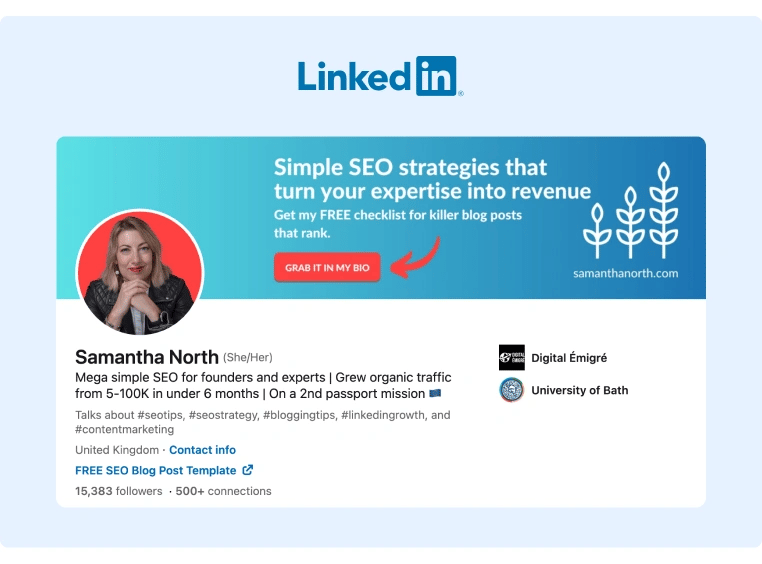
Source: Samantha North
Use the Same Personal Brand Statement Across the Web
Use the same personal brand statement across all of your social media profiles to become known in your industry for a specific specialty.
If you have a slightly different personal brand statement across various platforms, you'll confuse the people who are interested in you and even turn them off if they initially resonated with your first personal brand statement.
Approach your personal branding strategy as you would a company's brand strategy by maintaining the same message across the web.
Create Content That Supports Your Personal Brand Statement
If you claim you're excellent at helping startups scale their SEO from the first 1,000 to 10,000 monthly visitors, most of your content should focus on tactics and case studies getting from 1,000 to 10,000 monthly visits.
If you deviate from your personal brand statement and start talking about getting your first 500 visitors, building a website from scratch, or a case study of working with a Fortune 500 client, you'll lose the attention of the people who resonated with your initial personal brand statement.
10 Examples of Excellent Personal Brand Statements
Example #1: Julia McCoy
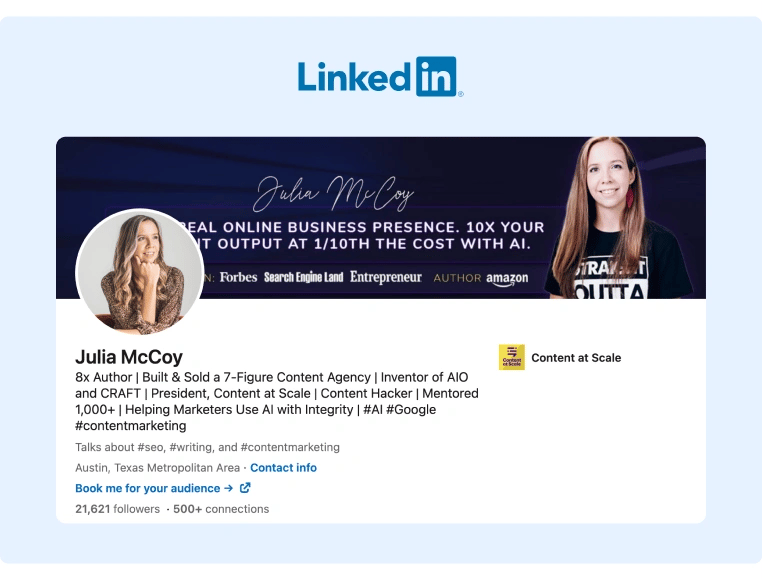
Source: Julia McCoy
The first personal brand statement example is from content marketer Julia McCoy.
First, it clearly communicates that she's a content marketer. Then, it communicates her unique value: helping agency owners use high-integrity AI-powered content.
If you're an agency owner looking to use AI-powered content at scale, it automatically captures your attention.
She also establishes her credibility by stating that she's a published author with eight books, and adds her title as President at Content at Scale and a Creator at Content Hacker.
Finally, McCoy includes a few relevant hashtags to help potential clients/recruiters find her profile more easily. As a general rule of thumb, use no more than three or four hashtags following your personal brand statement.
Example #2: Tim Ferriss
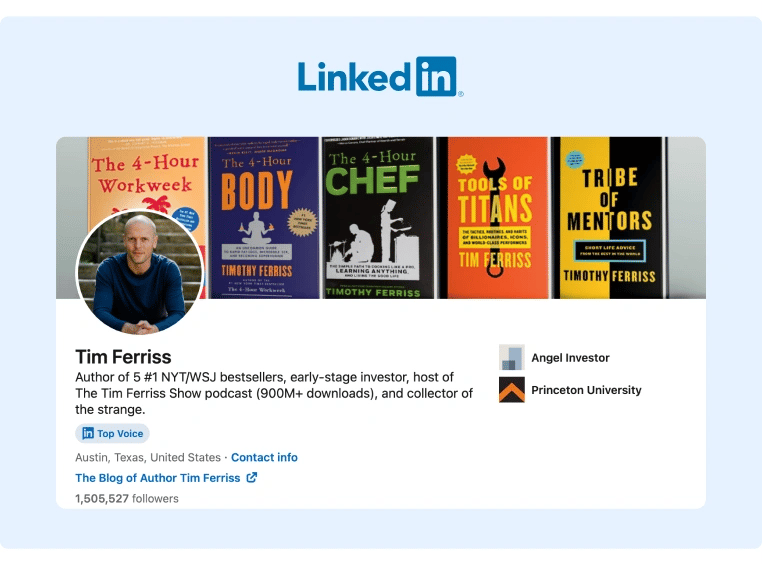
Source: Tim Ferriss
Tim Ferriss is a unique figure as he's evolved substantially over the past several decades, and he doesn't fit nicely under a single label. However, his personal brand statement is still clear: he's an investor, author, and podcaster.
He also uses a unique format where he states what he does and then supports each one with credibility. For example:
- Author: Credibility is that he's a NYT/WSJ bestseller.
- Podcast Host: Credibility is that he receives 900M+ downloads.
The only one he doesn't add credibility to is the "early-stage investor" title, likely because the personal brand statement would have gotten too long. So, remember that your personal brand statement shouldn't be more than one or two lines. People must be able to glance at it and quickly understand the value you provide.
He also adds his own personality at the end, which can be a nice touch. However, notice that he adds this personality touch at the end of the personal brand statement rather than leading with it. Sure, people want to get to know who you are, but they want to know the value you provide first.
Example #3: Susan Cain
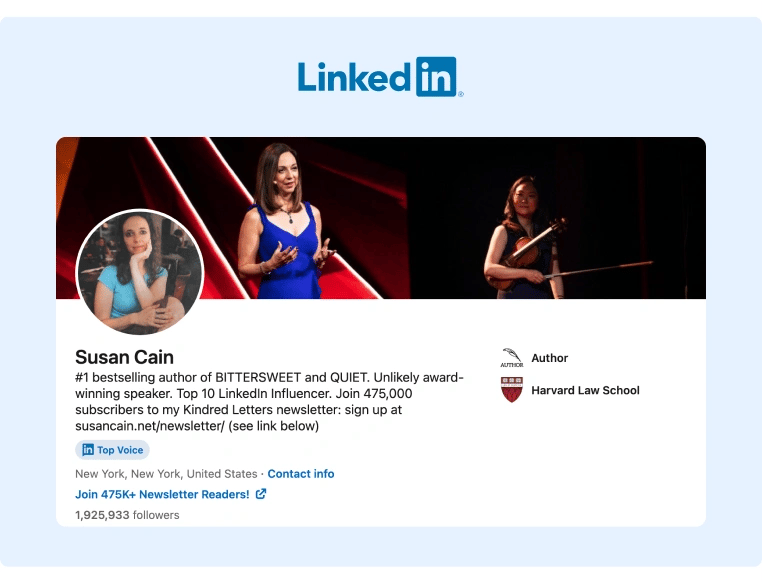
Source: Susan Cain
Susan Cain's personal brand statement leans heavily on establishing her credibility. She does this by stating her achievements as:
- A bestselling author.
- An award-winning speaker.
- A Top 10 LinkedIn Influencer.
- 475,000 subscribers.
She probably could have made her personal brand statement even stronger by saying who named her as a bestselling author and an award-winning speaker, but the other statistics also boost her credibility.
It's also evident what she does – she's a speaker and an author.
Finally, Cain adds a direct call-to-action (CTA) to her profile. You can add a CTA to the end of your personal brand statement, but make it a low ask (like signing up for a newsletter) rather than a high ask (like scheduling a demo).
Example #4: Katelyn Bourgoin
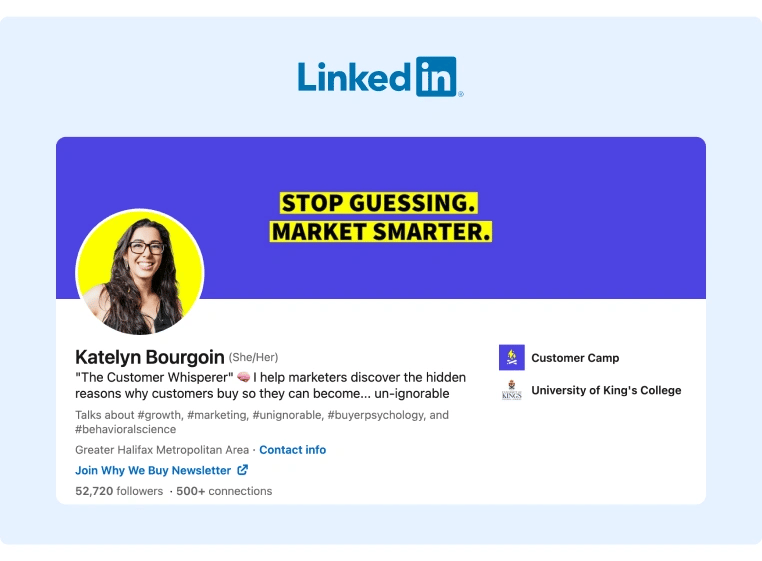
Source: Katelyn Bourgoin
Katelyn Bourgoin created her own label as "The Customer Whisperer." It's memorable and catchy, yet it still clearly communicates that she helps businesses understand their customers.
If you choose to create your own label, keep in mind that while it can be creative, it's more important that it's clear. In the next sentence, Bourgoin also clarifies any doubt that she works in customer research.
In fact, it does an excellent job of blatantly stating the outcome she helps businesses achieve: "become 'un-ignorable' to their customers."
She also specifies who she helps: marketers. If you wanted to make this personal brand statement even tighter, she could even state the industry she works with (e.g., SaaS, B2B, ecommerce, etc.).
Finally, she does a great job of letting her fun personality shine through with the catchy label, ellipsis, and made-up word, "un-ignorable." All three of these additions make her come across as a down-to-earth, likable person.
Example #5: Rand Fishkin
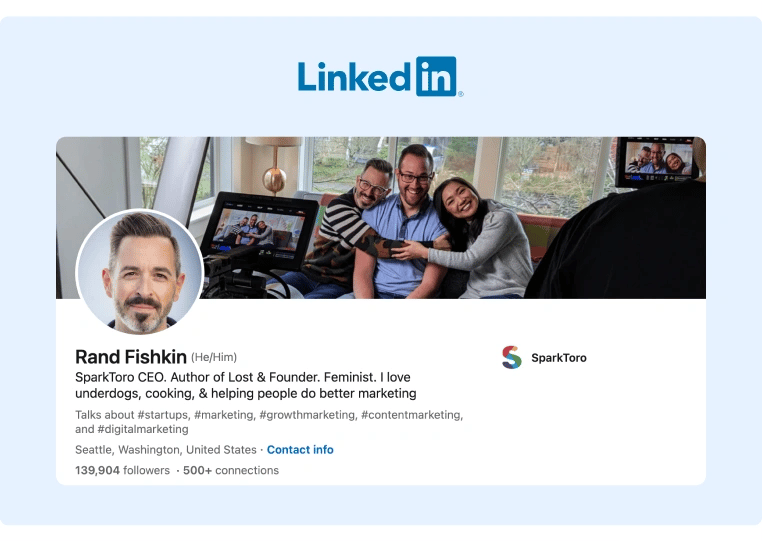
Source: Rand Fishkin
Rand Fishkin is an excellent example of a personal brand statement that follows a fairly straightforward formula yet still communicates his personality.
He leads by explaining who he is (the CEO of SparkToro), adds credibility by stating the book he wrote, and then adds some personality before wrapping up with the value he has to offer: helping people do better marketing.
This is a highly effective personal brand statement that proves you don't need to be overly creative to deliver a strong first impression.
Example #6: Chase Dimond
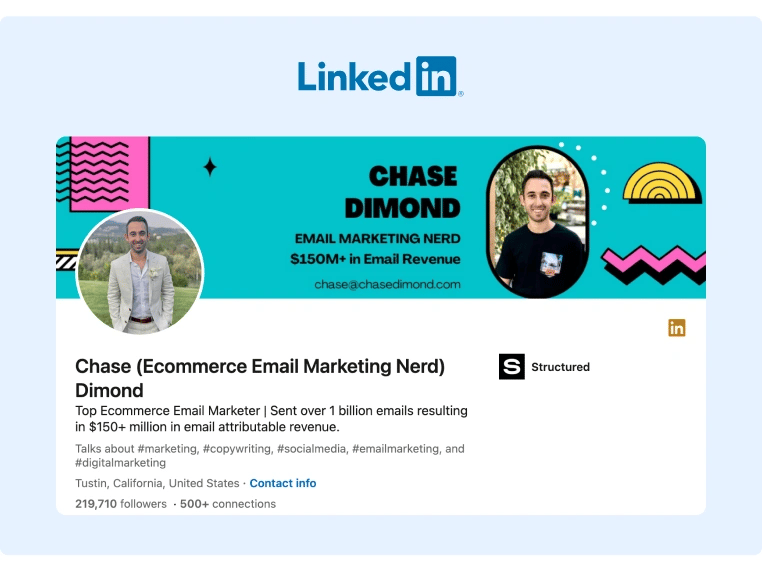
Source: Chase Dimond
Chase does an excellent job of defining his niche and expertise. Instead of just calling himself an "ecommerce marketer" or "email marketer," he positions himself in a more specific category, making him more desirable for ecommerce companies that need email marketing.
He also follows the attention-grabbing tagline (a top ecommerce email marketer) with statistics (generated over $150 million in email attributable revenue).
The statistic also acts as a highly effective hook to get anyone genuinely interested in email marketing to continue reading his profile.
He also adds "ecommerce email marketing nerd" as his middle name, which adds a little humor and makes him seem more approachable.
Example #7: Olivia Mae Hanlon
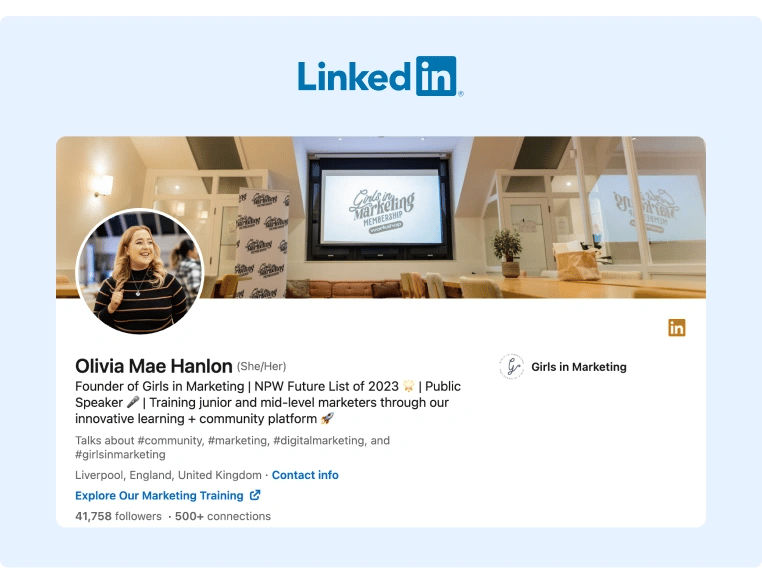
Source: Olivia Mae Hanlon
Olivia's personal brand statement follows a simple formula that anyone can swipe:
- Establish Who You Are: Founder of Girls in Marketing.
- Add Credibility: NPW Future List of 2023.
- State the Value You Provide: Training junior and mid-level marketers through our innovative learning and community platform.
One detail worth noting is that when she states her value, she specifically says who she helps (junior and mid-level marketers). Even though explicitly stating who you serve may turn away many people, it will automatically make you stand out to your target audience.
She also adds two emojis to her profile. While one or two relevant emojis can help capture attention, limit it to no more than two or three.
Example #8: Jessica Alba
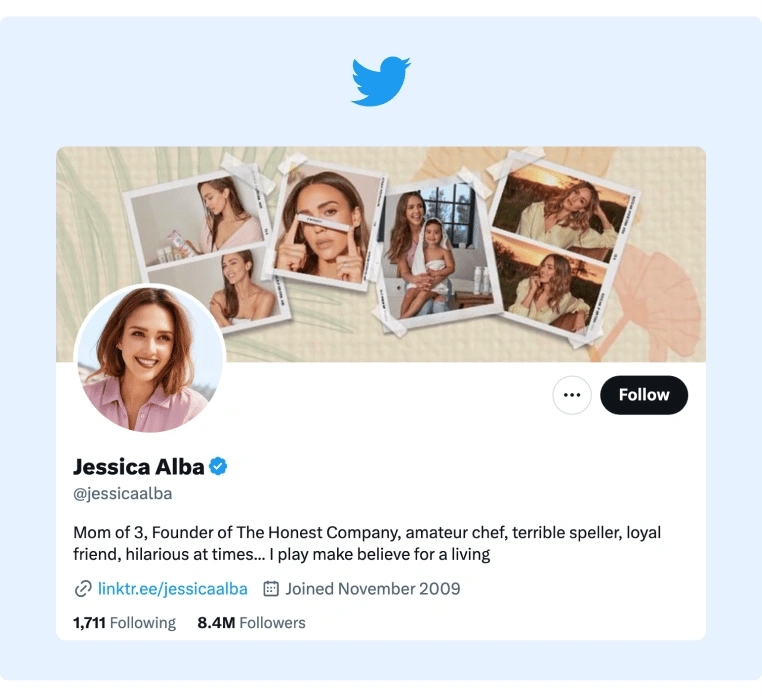
Source: Jessica Alba
Jessica Alba has accomplished so much that she doesn't really need to prove herself to the world. Simply stating "Founder of The Honest Company" is plenty of credibility, so she uses the rest of her profile to add humor and make herself seem relatable to the audience. Her philosophy, while intended to be humorous, also gives you a unique insight into how she looks at the world.
If you haven't founded a billion-dollar company, you might want to add some more credibility. You can take her lead by listing two to three interesting facts about you that make you likable. Those few fun facts can help make you memorable for a potential client or recruiter.
Example #9: Zain Kahn
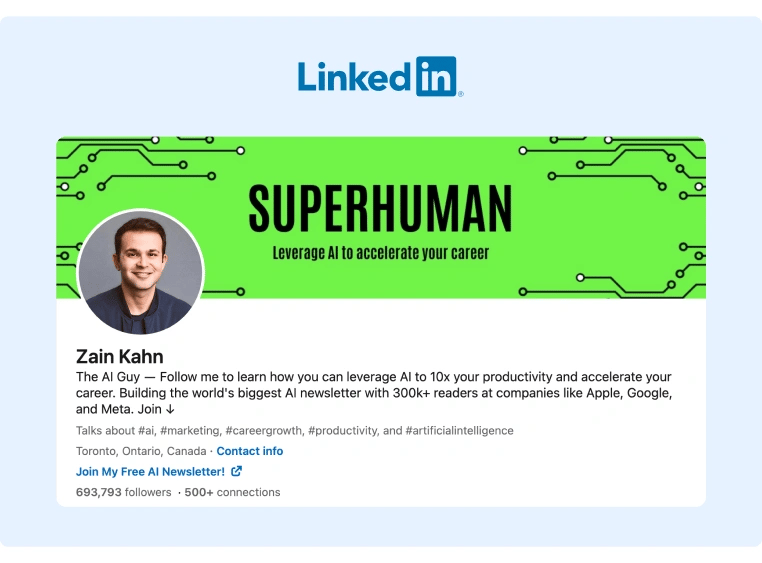
Source: Zain Kahn
Like Katelyn Bourgoin, Zain Kahn starts his personal brand statement with a catchphrase – The AI Guy. This makes it obvious to the reader that he's interested in AI, though admittedly, he could probably be a little more specific about what AI he specializes in. For example, should you follow him if you're an AI marketer? An AI engineer?
The second part, "Follow me to learn how you can leverage AI to 10x your productivity and accelerate your career," clearly outlines his value proposition: 10x your productivity and improve your career.
The final line is perhaps the most impactful as he finally states what he does (writes a newsletter) and adds credibility (he has 300,000 readers, and his readers are at companies like Apple, Google, and Meta).
Adding who his readers are is actually a great hack, as other Google, Meta, and Apple employees will probably be more likely to subscribe if they know their peers are also readers.
Again, if you have a newsletter or a small ask, you can add a CTA to subscribe following your personal brand statement.
Example #10: Justin Welsh
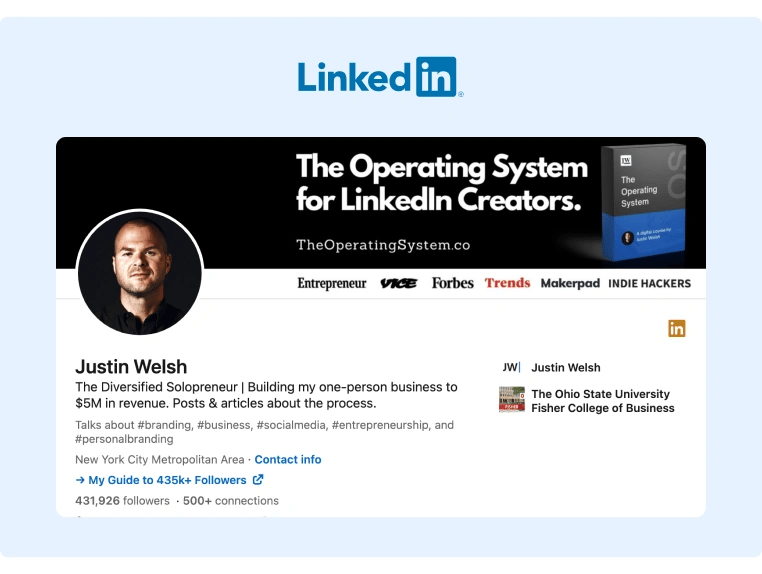
Source: Justin Welsh
Justin Welsh also opens his profile with an interesting catchphrase that clearly communicates who he is: a solopreneur.
He also uses the next line to further explain who he is (a one-person business) and add credibility ($5M in revenue). The final line tells you what you’ll get if you follow him: content about how he built a $5M in revenue business as a solo creator.
For solopreneurs who want to make more money, this is a highly intriguing personal brand statement and immediately captures the interest of the ideal target audience.
Build Your Own Personal Brand Statement Now
Hopefully the examples of personal brand statements above gave you the inspiration to write your own.
If you still feel stuck, pick one of the formulas and adapt it to your specific situation. Your personal brand statement will evolve over time, so don't feel this one has to be perfect.
If you want more help building a strong personal brand and establishing yourself as a thought leader, explore some of our other resources on building a social media presence.











